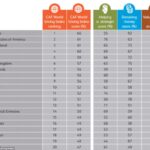We all know employee turnover is bad, but are you aware of how much it is costing your company? From decreased productivity (that can last for years) to the hiring an employment firm to help you find new employees, your company is losing a lot of cash as a result of employee turnover. We’ve put together a few other statistics about employee turnover that just might shock you.
1. Replacing employees may cost you up to 400% of their annual salary.
The cost to replace employees varies depending on the level of their position. For example, with entry-level employees, you may choose not to employ a hiring firm as most entry-level positions receive multiple applications with minimal advertisements.
Despite those apparent savings, replacing an entry-level employee can still cost your company 30-50% of the employee’s annual salary.
The more specialized the position, the more costly it is to replace the employees you have in the position. With mid-level employees, you should expect to spend up to 150% of their annual salary to replace them.
When you have to replace employees who are highly specialized or at the executive level, the price tag can be as high as 400% of their annual salary. Since these employees are often the most well-paid in the organization, the final amount can end up being staggering.
2. Up to 80% of employee turnover is a direct result of poor hiring decisions.
Even the most meticulous Human Resources personnel and hiring managers make poor hiring decisions from time to time. But poor hiring decisions have more to do with your hiring procedures than the people you have enacting them.
For example, most company’s hiring practices don’t take into account that a potential employee who has all the training, work experience, and skills needed for the position still may not be a great fit.
Employees who clash with their employer’s corporate culture are often dissatisfied and looking to switch jobs as soon as they can. Yet, most companies do not give alignment with corporate culture the same weight as other job requirements.
3. New employees may take as long as 2 years to reach the productivity level of their predecessors.
Everyone knows it will take new hires a little while to get the hang of things. During this time, you expect productivity loss for a few months, but it can actually take up to two years before the new employee is as productive as the person before them.
This is because productivity and efficiency are often things we figure out on the job. After a couple of years, employees have determined the best way to do their jobs and that’s what they do. New employees, on the other hand, lack on the job experience that can have a significant impact on their productivity. This is something that only comes with time.
4. Over 40% of companies do not have clear expectations or job titles for their employees.
One of the biggest problems contributing to employee turnover is a disconnect between the job description and the actual job. This disparity leads to frustration on both sides of the equation.
If you want employees to achieve goal targets, you need to provide them with a clear understanding of what is expected of them. Whenever possible, let the employee who is leaving write up a job description. After all, they are the people who know the ins and outs of what it actually takes to get their job done on a daily basis.
5. 40% of new employees who receive inadequate or poor job training will quit within a year.
Your employees want to do well at their jobs. Many are interested in moving up within the company. But there’s no way for them to move up that if they haven’t even been fully trained in their current position.
When your employees do not receive adequate training, almost any goals you set for them will be unattainable. This can be extremely discouraging for your employees. Without an appropriate job title and proper training, your employees may feel as though they have been set up to fail.
6. 60% of employees are likely to accept a lower paying job if it offers better benefits.
Many people mistakenly believe that money is the number one reason people switch jobs, but it’s not. This is not to say that salary isn’t important. If definitely is, but it is not the only or even primary, reason employees switch jobs.
Nearly two-thirds of American workers would be willing to accept a moderate salary decrease in exchange for better benefits. Remember, salary is just one piece of compensation. Your benefits package may make or break your attrition rate.
7. More than 50% of stay at home moms will seek out companies with family-friendly benefits when they return to work.
Stay at home moms, and stay at home dads too, often leave the workforce due to company policies that do not support parents with young children. As a result, they may feel that they have pushed out of their careers until their kids get a bit older.
But stay at home parents who are returning to the workforce will search for companies that offer family-friendly benefits. For the right benefits, they might even be willing to return to work earlier than expected. The ability to work from home, generous sick leave policies, and paid parental leave are just a few of the family-friendly benefits guaranteed to attract top talent, who happen to be parents.
8. 25% of the American workforce voluntarily left their jobs in 2015.
Even if none of the other statistics have stood out to you thusfar, this one should make you sit up and pay attention. One full quarter of the American workforce decided to quit their jobs in 2015.
To put it into perspective, it means that literally millions of Americans chose to voluntarily leave their jobs. If your company reflected that national average, you would need to replace one out of every four employees. For comparison, a healthy attrition rate, according to Forbes magazine would be less than 15%.
9. More than 25% of all employees are considered high risk for attrition.
An employee who is at high risk for leaving is one who is either dissatisfied or at least not thriving and engaged with your company. Employees who are not challenged in their roles and do not feel valued by their managers are considered high-retention-risk.
One of the best ways to retain employees who fall into the high-risk category is to engage with them. Do you know if your employees feel challenged? Bored? Overwhelmed?
When you have your finger on the pulse of your employee morale, you are able to get a clear picture of what you are doing well and how you can improve your employee retention.
Don’t forget to recognize the achievements of your employees and reward them for going above and beyond.
10. 93% of Millenials changed employers when they moved into a new position.
Let’s be honest, switching employers is a pain. There’s paperwork to fill out, benefits to compare and set up, and at least some degree of a learning curve.
So why would nearly all Millennials change to a new company when they took on a new role? While each individual situation is different, many reported being unable to move up into the new position with their current employer.
Employees who feel stagnant in their career are going to leave, period. If you want to retain your employees, you need to find a way for them to advance in house – otherwise, they will go looking out of the company.
Takeaway
Ready to find out how much employee turnover is costing you? Our 2017 Attrition Calculator can help. All you need to do is fill out the average number and average salary of your entry level, mid-level, and executive level employees. From there, we will tell you what your company is spending on attrition rates every single year. The number may surprise you. Click here to give it a try today.


































































































































